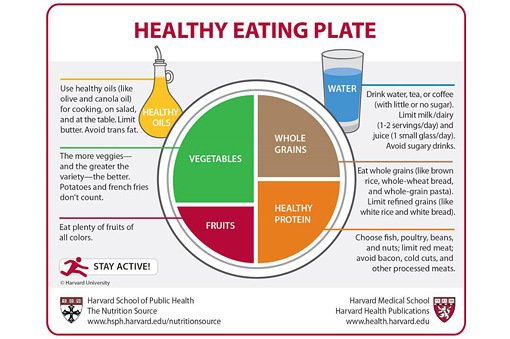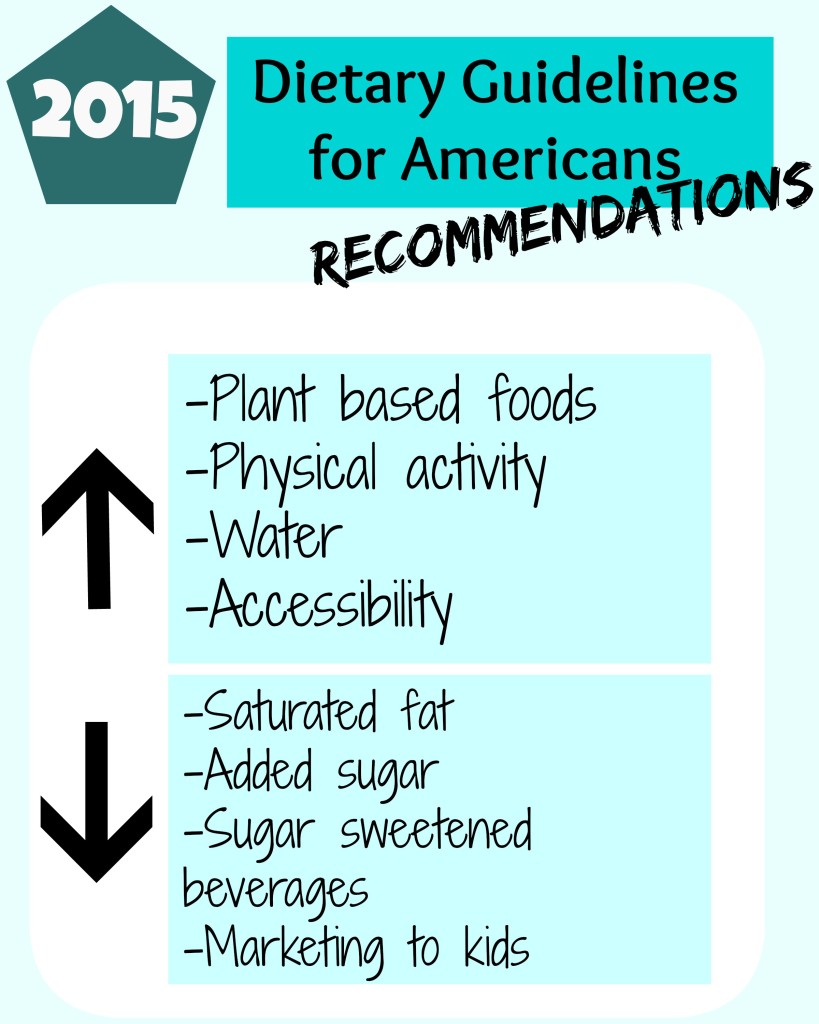“Eat More Plants!” Advice for 2015 Dietary Guidelines
I know…can you believe it’s taken me so long to write about the new, 2015 Dietary Guidelines Advisory Committee’s report?!
This past week in nutrition was HUGE. The 2015 Dietary Guidelines Advisory Committee released their [500+ page] report on what they think are the most important things to include in the actual 2015 Dietary Guidelines that will be released by the end of the year.
What are the Dietary Guidelines? Let me give you a short history lesson (and review for my Proteins, Carbs, and Fats exam):
- The Dietary Guidelines for Americans (DGAs) were created just as the connection between macronutrients (proteins, fats, and carbs) and chronic diseases was established.
- The Guidelines are revised every 5 years with new emerging research and science!
- 1980: The first DGAs were issued by the USDA.
- 1985: Not much changed in the 2nd edition of the DGAs.
- 1990: Quantitative recommendations for fat, saturated fat, and dietary cholesterol intake were made.
- 1995: Healthy weight charts and nutrition labels were added to the DGAs.
- 2000: Recommendations for physical activity were made for the first time. Recommendations were split for grains and fruit/vegetables instead of lumping them into one category.
- 2005: A new category, “discretionary calories” from solid fats, added sugars, and alcohol, was established. Limits in sodium intake (< 2,300 mg/d) were created.
- 2010: “Discretionary calories” was replaced by SoFAS [Solid Fats and Added Sugars]. Limits on refined grains were supported, as well as, the “meat and bean” group was expanded to be called “protein foods.”
- 2015: Yet to be determined…read on…
Politics have been known to play a role (hello dairy and meat subsidies) in the formation of the DGAs, but the advisory committee’s recommendations (from my knowledge) try to ignore bias and focus on the SCIENCE (hence the backlash experienced)!
There have been numerous news reports and opinions about the recommendations from the advisory committee, but one thing is for certain, great changes are in store…and some are even veg-friendly! (woooooo!) I have not included a comprehensive list below, but I have included what I think are some of the most important changes to be made!
Let’s take a closer look at some highlights of this year’s recommendations:
INCREASE:
Plant-based foods!!!
For the first time, the advisory committee recommends a plant-based diet for optimal health. Not only have multiple studies found veggie-friendly dietary habits to be associated with increased longevity, but also reduced risk of disease. The advisory committee goes one step further in explaining the SUSTAINABILITY of a plant-based diet (happy planet!)! Oh, and chronic disease prevention too!
If you’re not participating in #MeatlessMonday yet…perhaps it’s time?!
Physical activity!
I know it’s called the Dietary Guidelines, but since 2000 physical activity has been incorporated into the guidelines because, well, we know it’s good for us! Find a workout you love and you go girl (guy)!
Accessible healthy food to underserved locations.
Food deserts, as they’re referred to in industry, are more common in underserved, urban, low socioeconomic status geographic locations. The lack of supermarkets and farmer’s markets, lead to higher prices and less affordable healthy food. I know New York City has made great efforts with the Greenmarket program to expand fresh produce to these areas and it’s time the rest of the nation does as well!
Water intake instead of sugar-sweetened beverages.
Soda tax??? It may be on it’s way into our lives. Try replacing your daily pop with seltzer water for the same bubbly satisfaction for way less sugar, calories, and cavities!
REDUCE:
Saturated fats.
Replace the heart-unhealthy fats with heart-healthy UNsaturated fats. What does this mean in terms of food? Eat more avocado, nuts, fish, and olive oil and limit, dairy and even coconut oil.
Added sugar intake.
Just the other day I had to clarify to a friend that not all sugar is bad. There is a remarkable difference between natural sugar from fruit and vegetables and that from pastries, soda, and candy. There is a strong association between excessive sugar intake at type 2 diabetes, stroke, CVD, and obesity.
The Advisory Committee set its recommendations to less than 10% of total energy intake, which is about 200 calories based on a 2,000 calorie per day diet.
Sugar-sweetened beverages in schools. Hallelujah!
MARKETING of unhealthy foods to children.
We are all bombarded with hundreds of food messages each day. Children are especially vulnerable to these messages that can lead to detrimental health outcomes. (I’m talking to you sugary cereal cartoons!) It’s no surprise then that it’s so difficult to take your child food shopping without having an argument and/or tantrum over some sugary processed food item. I’m not saying that these products have to 100% disappear (although a makeover of many of them would be nice), but the marketing efforts directly to children must be reduced. I’m 110% in agreement with this effort and will let the committee know!
If you have any opinions on the Guidelines, you are encouraged to submit a written comment to the advisory panel by April 8, 2015.
I think one of the most significant things to remember when planning what you and your family eat is BALANCE. Be sure half of your plate, at most meals, is vegetables and fruits. Choose lean protein sources that are grilled, broiled, baked, poached, or steamed instead of fried or sauteed in excessive oil. Teach your kids (and yourself) the importance of whole grains over refined starches (they have more fiber, healthy fats, and even protein). Eat a rainbow of colors most days. Try eating meat-free one day weekly to benefit your health and the planet.
If you have any questions about the Guidelines, let me know!
XO




 Hi there!
Thanks for stopping by! I'm Chelsey, an online Registered Dietitian, recipe developer, budding photographer, and coffee addict! My mission is to help you feel good through food by answering the question "What should I eat?" Let's make nutrition approachable!
I hope you enjoy my personal collection of simple, healthy, food allergy friendly and nutritiously delicious recipes, plus tips and tons of tricks that will help YOU live a nutritionally-balanced life! I look forward to getting to know you better...
Hi there!
Thanks for stopping by! I'm Chelsey, an online Registered Dietitian, recipe developer, budding photographer, and coffee addict! My mission is to help you feel good through food by answering the question "What should I eat?" Let's make nutrition approachable!
I hope you enjoy my personal collection of simple, healthy, food allergy friendly and nutritiously delicious recipes, plus tips and tons of tricks that will help YOU live a nutritionally-balanced life! I look forward to getting to know you better...







